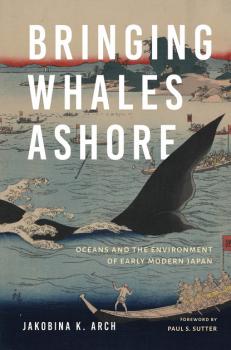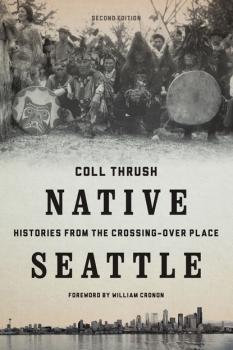Weyerhaeuser Environmental Books
Скачать книги из серии Weyerhaeuser Environmental BooksSeeds of Control
Japanese colonial rule in Korea (1905–1945) ushered in natural resource management programs that profoundly altered access to and ownership of the peninsula’s extensive mountains and forests. Under the banner of “forest love,” the colonial government set out to restructure the rhythms and routines of agrarian life, targeting everything from home heating to food preparation. Timber industrialists, meanwhile, channeled Korea’s forest resources into supply chains that grew in tandem with Japan’s imperial sphere. These mechanisms of resource control were only fortified after 1937, when the peninsula and its forests were mobilized for total war.In this wide-ranging study David Fedman explores Japanese imperialism through the lens of forest conservation in colonial Korea—a project of environmental rule that outlived the empire itself. Holding up for scrutiny the notion of conservation, Seeds of Control examines the roots of Japanese ideas about the Korean landscape, as well as the consequences and aftermath of Japanese approaches to Korea’s “greenification.” Drawing from sources in Japanese and Korean, Fedman writes colonized lands into Japanese environmental history, revealing a largely untold story of green imperialism in Asia.
Footprints of War
When American forces arrived in Vietnam, they found themselves embedded in historic village and frontier spaces already shaped by many past conflicts. American bases and bombing targets followed spatial and political logics influenced by the footprints of past wars in central Vietnam. The militarized landscapes here, like many in the world�s historic conflict zones, continue to shape post-war land-use politics.Footprints of War traces the long history of conflict-produced spaces in Vietnam, beginning with early modern wars and the French colonial invasion in 1885 and continuing through the collapse of the Saigon government in 1975. The result is a richly textured history of militarized landscapes that reveals the spatial logic of key battles such as the Tet Offensive.Drawing on extensive archival work and years of interviews and fieldwork in the hills and villages around the city of Hue to illuminate war�s footprints, David Biggs also integrates historical Geographic Information Systems (GIS) data, using aerial, high-altitude, and satellite imagery to render otherwise placeless sites into living, multidimensional spaces. This personal and multilayered approach yields an innovative history of the lasting traces of war in Vietnam and a model for understanding other militarized landscapes.
Bringing Whales Ashore
Today, Japan defends its controversial whaling expeditions by invoking tradition�but what was the historical reality? In examining the techniques and impacts of whaling during the Tokugawa period (1603�1868), Jakobina Arch shows that the organized, shore-based whaling that first developed during these years bore little resemblance to modern Japanese whaling. Drawing on a wide range of sources, from whaling ledgers to recipe books and gravestones for fetal whales, she traces how the images of whales and byproducts of commercial whaling were woven into the lives of people throughout Japan. Economically, Pacific Ocean resources were central in supporting the expanding Tokugawa state.In this vivid and nuanced study of how the Japanese people brought whales ashore during the Tokugawa period, Arch makes important contributions to both environmental and Japanese history by connecting Japanese whaling to marine environmental history in the Pacific, including the devastating impact of American whaling in the nineteenth century.�
Cultivating Nature
The watery terrain of the Albufera Natural Park, an area ten kilometers south of Valencia that is widely regarded as the birthplace of paella, has long been prized by residents and visitors alike. Since the twentieth century, the disparate visions of city dwellers, farmers, fishermen, scientists, politicians, and tourists have made this working landscape a site of ongoing conflict over environmental conservation in Europe, the future of Spain, and Valencian identity.In�Cultivating Nature, Sarah Hamilton employs the Albufera�s contested lands and waters, which have supported and been transformed by human activity for a millennium, as a lens bringing regional, national, and global social histories into sharp focus. She argues that efforts to preserve biological and cultural diversity must incorporate the interests of those who live within heavily modified and long-exploited ecosystems such as the Albufera de Valencia. Shifting between local struggles and global debates, this fascinating environmental history reveals how Franco�s dictatorship, Spain�s integration with Europe, and the crisis in European agriculture have shaped the Albufera, its users, and its inhabitants.�
Seismic City
On April 18, 1906, a 7.8-magnitude earthquake shook the San Francisco region, igniting fires that burned half the city. The disaster in all its elements – earthquake, fires, and recovery – profoundly disrupted the urban order and challenged San Francisco’s perceived permanence.The crisis temporarily broke down spatial divisions of class and race and highlighted the contested terrain of urban nature in an era of widespread class conflict, simmering ethnic tensions, and controversial reform efforts. From a proposal to expel Chinatown from the city center to a vision of San Francisco paved with concrete in the name of sanitation, the process of reconstruction involved reenvisioning the places of both people and nature. In their zeal to restore their city, San Franciscans downplayed the role of the earthquake and persisted in choosing patterns of development that exacerbated risk.In this close study of the 1906 San Francisco earthquake, Joanna L. Dyl examines the decades leading up to the catastrophic event and the city’s recovery from it. Combining urban environmental history and disaster studies, Seismic City demonstrates how the crisis and subsequent rebuilding reflect the dynamic interplay of natural and human influences that have shaped San Francisco.
Smell Detectives
What did nineteenth-century cities smell like? And how did odors matter in the formation of a modern environmental consciousness? Smell Detectives follows the nineteenth-century Americans who used their noses to make sense of the sanitary challenges caused by rapid urban and industrial growth. Melanie Kiechle examines nuisance complaints, medical writings, domestic advice, and myriad discussions of what constituted fresh air, and argues that nineteenth-century city dwellers, anxious about the air they breathed, attempted to create healthier cities by detecting and then mitigating the most menacing odors.Medical theories in the nineteenth century assumed that foul odors caused disease and that overcrowded cities—filled with new and stronger stinks—were synonymous with disease and danger. But the sources of offending odors proved difficult to pinpoint. The creation of city health boards introduced new conflicts between complaining citizens and the officials in charge of the air. Smell Detectives looks at the relationship between the construction of scientific expertise, on the one hand, and “common sense”—the olfactory experiences of common people—on the other. Although the rise of germ theory revolutionized medical knowledge and ultimately undid this form of sensory knowing, Smell Detectives recovers how city residents used their sense of smell and their health concerns about foul odors to understand, adjust to, and fight against urban environmental changes.
Native Seattle
This updated edition of Native Seattle brings the indigenous story to the present day and puts the movement of recognizing Seattle's Native past into a broader context. Native Seattle focuses on the experiences of local indigenous communities on whose land Seattle grew, accounts of Native migrants to the city and the development of a multi-tribal urban community, as well as the role Native Americans have played in the narrative of Seattle.
How to Read the American West
From deserts to ghost towns, from national forests to California bungalows, many of the features of the western American landscape are well known to residents and travelers alike. But in How to Read the American West, William Wyckoff introduces readers anew to these familiar landscapes. A geographer and an accomplished photographer, Wyckoff offers a fresh perspective on the natural and human history of the American West and encourages readers to discover that history has shaped the places where people live, work, and visit.This innovative field guide includes stories, photographs, maps, and diagrams on a hundred landscape features across the American West. Features are grouped according to type, such as natural landscapes, farms and ranches, places of special cultural identity, and cities and suburbs. Unlike the geographic organization of a traditional guidebook, Wyckoff's field guide draws attention to the connections and the differences between and among places. Emphasizing features that recur from one part of the region to another, the guide takes readers on an exploration of the eleven western states with trips into their natural and cultural character.How to Read the American West is an ideal traveling companion on the main roads and byways in the West, providing unexpected insights into the landscapes you see out your car window. It is also a wonderful source for armchair travelers and people who live in the West who want to learn more about the modern West, how it came to be, and how it may change in the years to come.Showcasing the everyday alongside the exceptional, Wyckoff demonstrates how asking new questions about the landscapes of the West can let us see our surroundings more clearly, helping us make informed and thoughtful decisions about their stewardship in the twenty-first century.Watch the trailer: http://www.youtube.com/watch?v=aYSmp5gZ4-I
Defending Giants
Giant redwoods are American icons, paragons of grandeur, exceptionalism, and endurance. They are also symbols of conflict and negotiation, remnants of environmental battles over the limits of industrialization, profiteering, and globalization. Since the middle of the nineteenth century, logging operations have eaten away at the redwood forest, particularly areas covered by ancient giant redwoods. Today, such trees occupy a mere 120,000 acres. Their existence is testimony to the efforts of activists to rescue some of these giants from destruction. Very few conservation battles have endured longer or with more violence than on the North Coast of California, behind what locals call the Redwood Curtain. Defending Giants explores the long history of the Redwood Wars, focusing on the ways rural Americans fought for control over both North Coast society and its forests. Activists defended these trees not only because the redwood forest had dwindled in size, but also because, by the late twentieth century, the local economy was increasingly dominated by multinational corporations. The resulting conflict—the Redwood Wars—pitted workers and environmental activists against the rising tide of globalization and industrial logging in a complex war over endangered species, sustainable forestry, and, of course, the fate of the last ancient redwoods. Activists perched in trees and filed lawsuits, while the timber industry, led by Pacific Lumber, fought the lawsuits and used their power to halt reform efforts. Ultimately, the Clinton administration sidestepped Congress and the courts to negotiate an innovative compromise. In the process, the Redwood Wars transformed American environmental politics by shifting the balance of power away from Congress and into the hands of the executive branch.
The City Is More Than Human
Winner of the 2017 Virginia Marie Folkins Award, Association of King County Historical Organizations (AKCHO)Winner of the 2017 Hal K. Rothman Book Prize, Western History AssociationSeattle would not exist without animals. Animals have played a vital role in shaping the city from its founding amid existing indigenous towns in the mid-nineteenth century to the livestock-friendly town of the late nineteenth century to the pet-friendly, livestock-averse modern city. When newcomers first arrived in the 1850s, they hastened to assemble the familiar cohort of cattle, horses, pigs, chickens, and other animals that defined European agriculture. This, in turn, contributed to the dispossession of the Native residents of the area. However, just as various animals were used to create a Euro-American city, the elimination of these same animals from Seattle was key to the creation of the new middle-class neighborhoods of the twentieth century. As dogs and cats came to symbolize home and family, Seattleites’ relationship with livestock became distant and exploitative, demonstrating the deep social contradictions that characterize the modern American metropolis. Throughout Seattle’s history, people have sorted animals into categories and into places as a way of asserting power over animals, other people, and property. In The City Is More Than Human , Frederick Brown explores the dynamic, troubled relationship humans have with animals. In so doing he challenges us to acknowledge the role of animals of all sorts in the making and remaking of cities.









